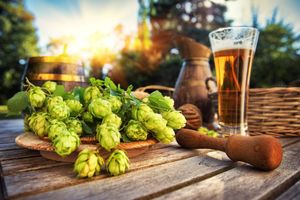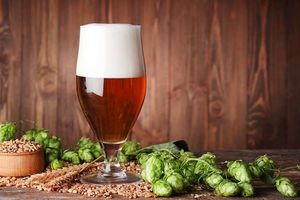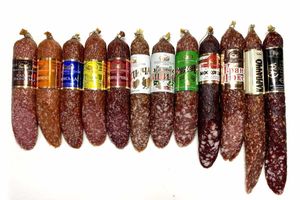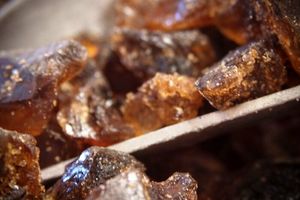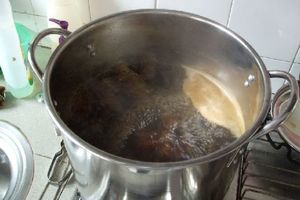Is my beer spoiled?
This question is probably the most common among beginners. And the most frequent answer is no. Of course, it all depends on the situation, but more often than not, it can be limited to an unwanted taste or smell, and the batch will still be drinkable, learning lessons for further experiments.
While anything can happen to beer, usually problems are rooted in a small block of causes. If the recipe was correct and the ingredients were fresh, where could you have gone wrong: bad disinfection, bad yeast, wrong temperature.
Most often, the problem appears when the beer is already in the fermentation tank and nothing (or something strange) happens. Let's look at a few common symptoms and their causes.
FREQUENT PROBLEMS
SYMPTOM: I ADDED YEAST TWO DAYS AGO AND NOTHING HAPPENS
Reason 1: Leakage of carbon dioxide from the tank. Fermentation problems can be the result of various factors. A loosely closed hydraulic lock will not tear out. That is, fermentation proceeds, and carbon dioxide seeps into the cracks.
What to do: This isn't really a problem and won't harm your beer. Fasten the water lock tighter, and next time fit the lid better.
Reason 2: bad yeast. If there is no fermentation, then something is wrong with the yeast. Well-packaged and properly stored yeast should be good for two years. But if you took yeast from a dusty bag stuck to a dusty jar of extract, you may not be resuscitating it. Never take such yeast. Yeast must be handled carefully, creating optimal conditions for its growth. Dry yeast has been specially deprived of water, so it cannot begin to work. They need a nice warm soak, time to come to life, maybe an aperitif before they get down to the real processing. If you pour dry yeast into the wort, some will, of course, come to life, but not all.
What to do: Soaking the yeast in clean water is highly recommended by the laws of osmosis. Dry yeast has a sufficient supply of sugar to start activity, so you can soak without sugar. Since the wort has a high concentration of sugar, the yeast cannot take water from it through the cell membranes. The water remains locked in the wort and dissolves the sugars. A friend of mine, who wished to remain anonymous, understood the term "introduce the yeast" so much that he began to forcefully throw the yeast into the wort to wet it.
But it didn't work very well. Even liquid yeast needs a warm-up. They have been in the fridge for a long time and now they need to warm up and eat to be ready for work. There is much more yeast in a bag of dry cells than in liquid ones. Therefore, the latter must be fermented and given time to multiply to the required number. Either way, the yeast needs time before it gets going. Aeration, i.e. oxygen saturation of the wort, is also important for them. The more oxygen, the faster and more readily the yeast divides.
Reason 3: It is very cold. If you place even healthy yeast in a wort that is too cold, they will not wander. Ale strains have different fermentation temperatures, but they hibernate below 16 °C. If you soaked the yeast in warm water (40 ° C) and then added to 18 ° C wort, do not expect anything good - they will have a temperature shock and a long lag time. Even normal conditions can seem so "warmed up" to winter cells.
What to do: increase the temperature in the tank by several degrees.
Reason 4: insufficient disinfection. It can go a long way. Did you properly boil and cool the water for the starter? If the starter is colder than 27 °C, the yeast will be too cold. If it's over 41°C, the yeast will feel scalded and refuse to deal with your wort. And if you boiled the yeast, it is already dead.
What to do: Add new yeast.
SYMPTOM: I ADDED YEAST YESTERDAY IT WAS BUBBLING ALL DAY AND NOW IT'S STOPPED/REDUCED
Reason 1: poor preparation. If the yeast is poorly prepared according to various parameters, it will not be able to finish its work.
What to do: Add new yeast.
Reason 2: It is very cold. Fermentation problems are often related to temperature. If the room or tank is very cold, even a few degrees at night, the fermentation will slow down significantly.
What to do: try to maintain a constant temperature in the tank and the yeast will not remain in debt.
Reason 3: It's very hot. The flip side of the coin is if the temperature in the vat is higher than 24 °C and the yeast has exceeded the plan. This often happens if there is too much yeast, then the primary fermentation can be completed in 48 hours. But this is not always good, because during fermentation above 21 ° C, phenols and ethers will appear in the beer, which can spoil the taste. The beer will not be irrevocably spoiled, it all depends on your taste preferences.
What to do: try to maintain a constant temperature in the tank, and the yeast will not remain in debt.
SYMPTOM: LAST TIME IT WAS SO, AND THIS TIME - DIFFERENTLY
Reason 1: different conditions. Different strains of yeast behave differently, and this may depend on the ingredients in the wort and the temperature. That is, different yeast can make different beer from different wort
at different temperatures. Convinced?
What to do: calm down! Do not rush to conclusions. Go watch TV. :)
Reason 2: Yeast health. If all conditions are exactly the same, different fermentation results may be due to yeast health, degree of aeration, or something else. But you should worry only if the smell or appearance is completely different.
What to do: observe.
SYMPTOM: THE HYDRAULIC VALVE IS CLOCKED
Reason: too strong fermentation. Sometimes the wort is so violent that the foam gets into the water lock. If it clogs, the pressure in the tank may increase and everything will end in an explosion.
What to do: it is best to switch to gas removal with a tube. Simply insert the tube into the lid of the vat and drain the gas into the water.
Symptom: something white/green/brown floating/growing/moving
Reason 1: normal fermentation. When you look into your tank for the first time, you will most likely be very surprised. There will be a white-yellow foam with green islands of hops and lees. But this is absolutely normal. You should worry only if something hairy grows on the surface of the wort. I remember one guy telling me that a bat had fallen into his tank. He definitely should have sounded the alarm.
What to do: Get a new bat.
Reason 2: mold. Just mold.
What to do: the mold can simply be removed from the surface of the wort, and it will not affect the taste of the beer in any way. Pour some wort through a siphon and taste it. If it is not tasty, you can pour the rest of the batch. But most likely the beer will not suffer. Mold in beer is safe. But still, be careful when disinfecting, and everything will be fine. Mold indicates that there is a lot of oxygen in the tank. It often appears if you ferment with fruit. If the yeast is active, it will maintain a layer of carbon dioxide. Pour this beer into a bottle or for aging in a vessel that can be filled to the brim.
SYMPTOM: SMELLS LIKE ROTTEN EGGS
Cause 1: Yeast strain. Such odors (hydrogen sulfide) have two causes: bacteria and a yeast strain. Many lager yeasts produce a decent amount of hydrogen sulfide. After the second exposure, these odors will disappear.
What to do: Let the beer settle and infuse for a few weeks after the first stage.
Reason 2: Bacteria. Bacterial infections also cause such smells, and if you do not have a camp, then most likely it is an infection. True, this rarely happens, but it means that you did not follow the disinfection regime
What to do: Let fermentation finish and taste the beer before bottling. If it is sour, bitter or has a spoiled taste, pour it out.
SYMPTOM: SMELLS SOUR
Cause 1: Bacteria. In this case, it is most likely acidobacteria (bacteria that secrete vinegar) and lactic acid bacteria - frequent enemies of brewers. Sometimes this infection will give off a sweet smell like malt vinegar, sometimes it will make it smell like cider. It all depends on what you have in your wort. Acidobacteria often turn some of the wort into a jelly-like slurp, and this is easy to see in the vat, along with the general turbidity of the wort (although the wort is often cloudy, especially with the whole grain method). Acidobacteria are anaerobic, so their presence means that your beer has a lot of oxygen.
What to do: If you don't like the taste, pour it out. But in some varieties, lactobacilli are even desirable. Be careful when disinfecting. A slightly sour beer can be saved by adding fruit.
Cause 2: Wild yeast and bacteria. There are two other culprits:
Brettanomyces (yeast strain) and pediococcus (bacteria). The first ones smell of horse sweat or cowherd. I personally think that the skin. Others produce diacetyl and sour odors, and make beer cloudy.
These microorganisms are very valuable for some styles, such as Belgian Lambic. But in other cases, if the beer resembles a lambic, it will be considered a drawback, and in some it will be carefully aged for several years. Lambics always have sharp bitterness and fruity notes. This beer is very refreshing and goes well with heavy food.
What to do: still carry out thorough disinfection so as not to accidentally make lambic.
SYMPTOM: DOESN'T STOP BUBBLING
Reason 1: It's cool. If the beer ferments without interruption for more than a week for ales and more than three weeks for lagers, it does not mean that something is wrong. This may mean that the temperature is not high and the yeast is not in a hurry.
What to do: This is a problem.
Cause 2: gushing infection. Constant tearing can be the result of a "fountain infection". This can happen under any conditions with any yeast due to wild yeast or bacteria eating unfermented matter, sugars and dextrins. As a result, the beer ferments until all the carbohydrates are broken down and the beer becomes almost tasteless. And after pouring, the beer foams very strongly and spills out of the bottle.
What to do: Sanitize better next time. If it boils too long, check the specific gravity with a hydrometer. To do this, pour part of the wort through a siphon and measure the density. If it is still high, between 10 and 20, then the reason is the first. If the density is less than 10, and the tearing has not ended, then the reason is second. In this case, the beer will be tasteless, and most likely you will pour it out. Saison yeast works slowly, so what
take your time with them. But they are often abandoned in favor of the usual yeast.
SYMPTOM: FERMENTATION It seems to have ended, and CP is 1.025
Reason 1: It's very cold. At the same time, it is often said that "fermentation has stopped." There are several reasons. The simplest and most common is temperature. As I said, if it's cold, the yeast hibernates and settles to the bottom.
What to do: Move the vat to a warmer room and stir the settled yeast.
Cause 2: Weak/insufficient yeast. This is another reason. We return to our thoughts on the preparation of yeast. If they are too weak and unprepared, they are unlikely to cope with thick wort. This happens especially if the NP is 1.078 and from.
What to do: add yeast.
Reason 3: Lots of non-fermentable sugars. This happens when cooking from an extract, if it contains a lot of dextrins.
What to do: the beer fermented as much as it could. If you want more fermentation, change the extract supplier, for example buy Muntons or Briess.
SYMPTOM: PROCESSING FAILS
The reason: more time is needed. For the implementation of the "wort fermentation and beer gasification" project, the state council in the form of yeast needs time and the appropriate temperature. And it is better if no one distracts him - meetings are held behind closed doors, with dimmed lights and warmth. If the committee's budget was sufficient (sugar), then it would reach consensus in two weeks. If they do not work even in a month, the staff of the office will have to be changed.
What to do: The yeast may have settled too soon - shake the bottles. Or move them to a warmer room. If the beer is kept for a long time, it is possible that there was not enough yeast. Then you need to add more.
SYMPTOM: TOO MUCH GAS IN THE BOTTLE
Reason 1: You added too much sugar before bottling.
What to do: remove the caps from the bottles, wrap the necks with foil and let the gas escape. Only the gas accumulated under the lid will come out, not the gas dissolved in the beer. Then close the bottles again.
Reason 2: early bottling. Before fermentation is complete.
What to do: Remove the caps and then close the bottles again.
Cause 3: Wild yeast. Again a bubbling problem. Microorganisms like pediococcus or wild yeast are really the problem. They will ferment the beer until nothing is left but bitter water with alcohol. Another danger is that the bottles will explode. Firstly, someone can be injured by a fragment, and secondly, the whole room will be contaminated.
What to do: Put the bottles in the fridge and try to drink as much as possible while there is still some taste left. I read a story on one forum where a guy and his friend both added 3/4 cup of sugar to a batch because each decided the other forgot to do it. After the first explosions, they removed all the covers and thought they had saved the situation. But soon there were new explosions. Be careful!
SYMPTOM: THE FINISHED BEER IS CLOUDY/VERY CLOUDY
Reason 1: improper cooling. This is the most common cause of such a problem. If during cooling of the wort, complete sedimentation of the suspensions did not occur, then the sediment will give turbidity in the wort, and then in the beer.
What to do: Use cooling elements.
Reason 2: starch. If you've brewed with grains and haven't allowed all the starches to convert, or have added to the extract wort/soaked grains that need mashing, your beer may have starch left over and that's why it's cloudy.
What to do: better check if you need to mash the malt. Watch the temperature while kneading and maybe increase the time.
Reason 3: Yeast. Some yeast strains do not settle well, such as German hefeweizen, and the beer will be cloudy with them.
What to do: if you don't like this beer, take other yeast.
In any case, turbidity can be removed by adding a brightener (gelatin, fish glue, Polyclar®, bentonite) after fermentation. With the whole grain method, you can add Irish moss or carrageenan at the end of boiling.
FREQUENT SWEETS
The taste and smell of beer consists of many factors. We used to call some components of beer aroma malty, fruity or bitter elements. Now it's time to figure out exactly why beer itself can smell bad. Let's take a look at some unpleasant odors in beer and their causes.
ACETALDEHYDE
The smell of green apples or fresh pumpkin, an intermediate stage of alcohol formation. Some strains of yeast produce this substance more than others, but usually this smell means that the beer is not ready yet and needs time to ferment.
To make beer less acetaldehyde:
reduce the rate of introduction of yeast;
saturate better with oxygen;
reduce the fermentation temperature.
To clean the vat of acetaldehyde:
increase the normalization and aging temperature of beer:
keep the beer on the yeast longer;
shake the yeast so that it does not settle;
use smaller yeast strains.
ALCOHOL
This is a rather characteristic smell, which can be soft and pleasant, as well as sharp. If the smell of alcohol is not felt in beer, it can be caused by several reasons. First, high fermentation temperature. Above 27 °C, the yeast begins to produce more heavy alcohols, whose taste threshold is lower than that of ethanol. They are sharp nand the taste, not quite like cheap tequila, of course, but still, that's not what we brew beer for. To reduce the formation of syushic alcohols during fermentation:
do not overdo the aeration and nutrients for the yeast;
add to cooled wort;
ferment at lower temperatures;
Do not add sucrose or other refined sugars to the wort.
Astringent TASTE
It's not just bitterness, it's a shriveled up feeling, like you've tried to suck on a used tea bag. As if your tongue has become dry and in flour, and the reason is often excess tannins. They form if you soak the grains too long or if you have alkaline water pH. The problem is quite common with light hop varieties and alkaline water. Tannins are also produced by over-rinsing or washing with water that is too hot. Another reason for their excess is a large amount of hops with a small content of alpha acids. Finally, beer can make your mouth sore due to bacterial contamination, such as acetic acid bacteria.
THE TASTE OF CIDER
We owe this taste to a too generous portion of cane or corn sugar. One of the components of cider flavor is acetaldehyde, which is also similar to a green apple. It is a common by-product of fermentation, and its amount depends on the yeast strain, temperature and conditions. As a result, acetic acid can form in the wort, and the beer resembles cider. If it is the result of acidobacteria, then there is nothing you can do about it, next time keep the fermentation tank away from fruit flies.
DIACETYL
Often, the presence of this substance causes the taste of butter or toffee. To get a good idea of what that smell is, smell an unopened bag of creamy microwave popcorn. In many ales this flavor is desirable, but to a certain extent, and often (especially in camps) it is best to avoid it, as it can cause a bitter smell. Diacetyl can be formed both during normal fermentation and during bacterial infections (pediococcus). If the process is normal, diacetyl is formed in the early stages of fermentation and is then broken down by yeast. If the lag period is too long (due to weak yeast or poor conditions), then too much diacetyl is formed, not all of it will have time to break down and will dominate the taste of the finished beer.
To reduce the diacetyl content in beer:
increase the rate of introduction of yeast so that the yeast divides less
do not add yeast heated to warmer wort;
do not overdo the aeration so that there is less oxygen during fermentation.
To clean the vat of diacetyl:
increase the temperature (for example, add a diacetyl pause);
keep the beer longer on the yeast;
shake the yeast so that it does not settle;
use smaller yeast strains.
DIMETHYLSULPHIDES (DMS) / TASTE OF COOKED VEGETABLES
This is an analogue of diacetyl in ales, but characteristic of camps. DMS are characterized by the smell of creamed corn in light varieties and tomatoes in darker ones. DMS are produced in the wort during boiling, when another component, S-methylmethionine (CMM), is broken down, which in turn is synthesized during brewing. When the malt is roasted or dried, the SMM breaks down, and the wort does not then form DMS, so this problem is more typical for light lagers. Another reason for the appearance of DMS can be a poor brewing technique or a bacterial infection. While the wort is warm, DMS are constantly formed in it, usually they evaporate with steam during boiling. If you cool the wort slowly, they will not evaporate, but will dissolve back into the wort. That's why it's important not to close the lid all the way when boiling or let the condensate drain back into the vat.
If the appearance of DMS is caused by an infection, they will taste more musty, like boiled cabbage or corn. This means that you did not disinfect the equipment well. If you reuse yeast from an infected batch, the problem will persist.
ETERANS/FRUIT PARKS
Ales should be slightly fruity, and Belgian and German wheat varieties suggest a slight banana taste (isoamyl acetate). But still, sometimes beer becomes similar in smell to a tropical grove or ethyl acetate (varnish remover). Esters are produced by yeast depending on the strain. Most of the ethers in beer are derived from ethanol, and only a few are derived from rye alcohols. The general rule is that the higher the fermentation temperature, the more esters are produced. To reduce the formation of esters:
saturate well with oxygen;
reduce the fermentation temperature;
use wort with a lower NP (less than 1.055);
use wort that ferments less;
Do not add sucrose and refined sugars to the wort.
HERBAL FLAVOUR
This is a consequence of poor storage of ingredients. If malt is stored improperly, it can become damp and smell musty. Aldehydes can form in old malt and also cause a grassy smell. A herbal (chlorophyll) odor will be evident in beer and improperly stored or packaged hops.
SHOVUKHA/GRAIN
Such smells and tastes are related to the viscous components contained in the shell of the grain. Most often, they are found in beer brewed from whole grains, if these grains were poorly cleaned from the husk. If lthe hops are very finely ground during grinding, as it happens at the Corona mill, most likely this taste will penetrate into the finished beer. To correct this defect, follow the same advice as for mouth-tying preferences. Another reason for the aftertaste of grain can be strongly roasted malt. If you are roasting the beans yourself, let them sit for at least two weeks after grinding so that all odors disappear. Keeping the beer in cold conditions for a month will also help the excess substances to settle together with the yeast.
MEDICINE
Sometimes you come across a description of the taste of pills, a first aid kit, or a spicy clove smell. The reason is various phenols, which are produced by yeast. Chlorophenol is a reaction product between chlorine-based disinfectants (bleaches) and phenols with a low taste threshold. The best way to protect yourself from such goodies is to rinse off the bleach well after cleaning with boiled water. Another cause can be wild yeast.
METAL
Metallic aftertaste is the result of dissolution of metals in wort or hydrolysis of lipids during improper storage of malt. If there is only a smell, but no taste, then this is not a problem. In large amounts, the metal can harm yeast and make beer cloudy. Cracks and scratches in steel tanks are often the cause, along with high iron content in the water. Stainless steel dishes will not cause such problems. Just like aluminum cookware, unless the water is very alkaline (above 9 pH), which is rare. Sometimes after boiling, a shiny aluminum tank can tarnish and become dark due to chlorine and carbonate in the water. The protective (gray) aluminum oxides can be restored by heating the dishes at high temperatures in the oven for about 6 hours.
MOLD
Mold is easy to recognize by smell and taste. Mold can form in wort and beer, as well as on brown bread. Contamination will easily happen if the fermentation vat is in a dirty or dusty place. If you spot mold early, it's easy to remove from the top layer of wort without much damage to the batch. But there's still a chance you won't remove everything and mold will continue to form. This problem is more common in plastic fermentation tanks, as plastic absorbs odors well and lets them into the vessel. Make sure that the bottom of the dry vat and malt are stored in the correct conditions.
OXIDATION
Perhaps the most common problem with beer, including industrial beer. If the wort is exposed to oxygen at temperatures above 27 °C, the beer will most likely taste like cardboard or cherry, depending on the oxidized components. When long-chain fatty acids are oxidized, trans-2-noneal is produced, which tastes like cardboard and smells like old paper.
SOAP
A soapy taste can appear if you do not rinse the dishes well or under certain conditions of fermentation. If you keep the wort in the first fermentation tank for a relatively long time after the end of the primary fermentation (the term depends on the variety), the fatty acids in the sediment layer can break down and cause a soapy aftertaste. In fact, soap is a salt of fatty acids, so when you try this beer, it's like you're drinking soap.
RESOLVER
These smells are similar to the smells of alcohol and ethers, only they are harsher. Their reason is a combination of high fermentation temperature and a large amount of oxygen. Another reason may be poor-quality plastic dishes or PVC pipes for draining the wort during filtration. In this case, it can be corrected by increasing the temperature. But still try to use high-quality plastic.
SKUNK
The smell of skunk or musk is caused by a photochemical reaction and isomerization of hop components. Such smells are caused by blue light waves and ultraviolet. They do not pass through the glass of dark bottles (brown, but not green). If the beer is stored in direct sunlight or fluorescent light, as in a supermarket, wait for the arrival of the skunk. If a pre-isomerized hop extract or a little hop is used, then there is nothing wrong with the world.
THE ODOR OF SWEAT/GOAT
I often smell this smell in restaurant draft beer. Maybe they need to clean the tap from mold or mold already in the beer itself, or maybe lactobacilli or pediococcus is the cause.
YEAST
The reason for this smell is easy to understand. If the beer is green, that is, too young, and the yeast has not had enough time to deal with it and settle, then you will taste it. Pour the beer more carefully so that the yeast remains in the bottle. If the yeast is unhealthy and autolysis begins, a substance will be released that may taste like yeast and smell like broth or soap or vitamin B.






